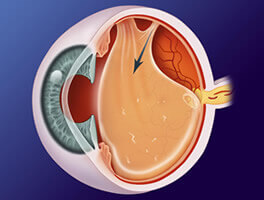Posterior Vitreous Detachment

Flashes and floaters are symptoms of the eye that commonly occur as a result of age-related changes to the vitreous gel. When we are born, the vitreous is firmly attached to the retina and is a thick, firm substance without much movement. But as we age, the vitreous becomes thinner and more watery. Vitreous debris that was once secure in the firm gel can now move around inside the eye, casting shadows on the retina. These shadows are called floaters and patients describe them in many different ways. Flashes in vision occur as a result of the vitreous tugging on the retina in the back of the eye, causing patients to see flashing lights or lightning streaks. Many people will experience floaters and flashes. Although they can occur with eye infection, eye inflammation, diabetes or after eye procedures, they frequently happen spontaneously. Flashes and floaters also may be the result of a posterior vitreous detachment (PVD). This is when the vitreous pulls forward away from the retina. Although flashes and floaters are common, especially as we age, it is important to see your doctor if you experience them as they may indicate a retinal tear or a retinal hole. Your doctor can distinguish between harmless flashes and floaters and those that may require treatment for an underlying condition.
Flashes, floaters and other visual disturbances that appear suddenly may indicate that the vitreous is pulling away from the retina and can lead to a retinal detachment. Anyone experiencing a sudden onset of flashes and floaters should seek immediate medical attention in order to reduce the risk of complications such as severe vision loss.
Most flashes and floaters will become less noticeable with time. Although these floaters are harmless, it is important to continue to receive regular eye exams to ensure that any permanent changes to your vision do not occur.
Treatment for Flashes and Floaters

Since they are typically harmless, flashes and floaters do not usually require treatment. However, some patients may need a retinal laser procedure to treat retinal tears or holes. This will prevent retinal detachment and blindness. In time, most of the symptoms of floaters and flashes improve or disappear.
Your doctor will determine which, if any, type of treatment is necessary for your individual condition after a thorough evaluation of your retina. Most patients with flashes and floaters maintain excellent vision.
LFT – Laser Floater Treatment (LFT) is the treatment of symptomatic vitreous floaters. These floaters look like small dots, lines or cobwebs in your field of vision. Floaters are small clumps of the vitreous gel that are located inside your eye.
Laser Floater Treatment (LFT) involves a specially designed laser that vaporizes the floaters. This laser takes minutes to perform and is done in an outpatient office setting.



